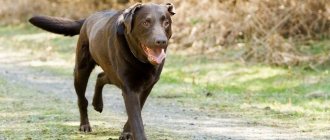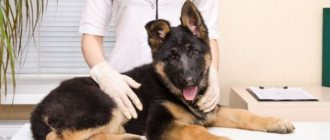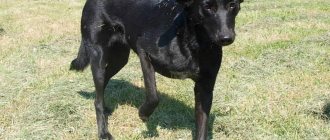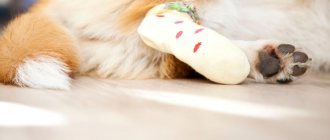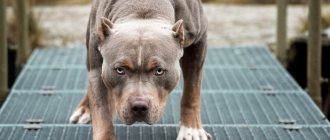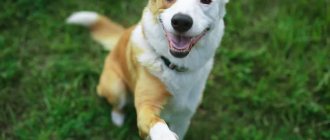Lameness in dogs is one of the most common problems caused by changes in gait due to gait dysfunction in one or more limbs. Usually this can be immediately detected, since the animal presses the sore paw, or leans only partially on it, redistributing the weight to healthy limbs. This is explained by the fact that the animal is trying to avoid pain when putting pressure on the sore paw, so it unconsciously tightens it and does not use it when walking. Lameness in a dog can be either a harmless phenomenon caused by a minor injury or a symptom of severe injury or a serious illness.
Dog lameness on the front leg
Lameness of the supporting limb is more common in dogs, since the front supporting legs are susceptible to various injuries. Jumping will pose the greatest danger, as the dog can twist a paw, sprain a ligament, or dislocate a limb if it lands poorly or encounters obstacles. Also dangerous will be slippery floors in the house, when the dog can simply slip and injure its paw, as well as shards of glass on the road and other sharp elements, when stepped on, the dog can cut the skin or get very seriously cut.
Thus, the front paws are more likely to be affected since they are the first paws the dog lands on. Jumping onto an uneven surface can cause dogs to become lame on the front leg, which can result in external injuries such as cuts and bruises, or internal injuries such as sprains and fractures. Another cause of damage and lameness in a dog's front leg is the ability to open doors inside the house or cabinet doors. When trying to pry on various objects, the dog may pinch its front paw, injure a finger, or tear off a claw.
The dog is limping on its hind leg
(c) Veterinary center for the treatment and rehabilitation of animals “Zoostatus”.
Varshavskoe highway, 125 building 1.
Lameness in dogs is a symptom of a number of pathologies, manifested in deterioration or absence of weight-bearing ability in one or more limbs. In addition to the usual understanding of lameness (stumbling gait), this can also include tucking in the paws, dragging, incorrect posture, and a complete inability to walk. Lameness can occur on one, two, three, or all four legs.
Types of lameness
There are 4 types of lameness:
- Leaning limb - the animal leans on its paw, but does not do it completely, leaning on a healthy limb and trying to quickly transfer weight to it. The stride of the affected paw becomes shorter. It is observed mainly in chronic processes and minor injuries. Tumors and arthrosis are characterized by the appearance of mild lameness, which progresses over time. Lameness in a dog's front leg can be observed due to elbow dysplasia.
- Hanging limb - the dog does not rest on its paw, but tucks it in, the limb constantly hangs in the air. Such lameness is typical for acute inflammation, dislocations of joints in dogs, fractures, and ligament ruptures. Lameness of the supporting and hanging limb can periodically change from one type to another.
- Intermittent - the dog's lameness goes away for a while, then occurs again. Often this is lameness of the supporting limb. Characteristic of the initial stage of joint dysplasia, osteochondrosis, and metabolic disorders. In case of chronic pathologies of the joints, it can occur after the dog stands on its paws, gradually disappearing during a walk. Intermittent hind leg claudication in small breed dogs is often caused by medial luxation of the patella or Perthes syndrome.
- A stiff gait - the dog seems to be protecting its sore paw. Often occurs with neurological disorders, when the characteristic muscle overstrain, causing a stiff gait, or excessive relaxation, in which the animal pulls up its paw. Sensitivity is reduced.
The Spitz does not step on its hind paw. Causes of temporary lameness. What to do
Hello. A week ago, my husband and I bought a Pomeranian Spitz, a 2.3-year-old female. The dog immediately found a common language with my husband, did not leave a single step, and was affectionate. Vivid aggression towards me. Unable to pet him, he starts growling. If I’m home alone, the dog sits in its place (under the table) and doesn’t come out. He doesn’t go outside with me, he even bites me. I give treats - he takes it warily and runs away. Please advise what to do in the described situation? I want understanding and affection from the dog. She didn’t scream, didn’t scold, didn’t hit. What to do?
Degrees of lameness
Lameness in dogs can also be classified according to the severity of the disease, how painful the lameness is and what pathological processes occur in the dysfunction of the limbs, different degrees of lameness are distinguished.
Usually there are three degrees: weak first degree, moderate second and strong third degree.
The first degree is a mild lameness, in which the animal can briefly lean on the sore paw and transfer its weight to it, or there is an arrhythmia in the movement of the sore paw. The animal seems to protect its paw and tries to use it for a minimum amount of time so as not to further injure it.
The second medium degree is observed when partial support is placed on the sore paw or when it is brought forward. Using the paw is already difficult for the animal, and the dog tries to press in or bring forward the sore limb.
The third, most severe degree of lameness is characterized by non-use of the affected limb; when walking, the animal cannot rest on the affected leg at all and has difficulty moving it. Movement will be very difficult, and painful symptoms require immediate assistance to the pet.
What to do?
It is worth noting that in the absence of practical experience, you should not even try to solve the problem on your own when a dog presses its back paw. If we talk about the potential discovery of a splinter or glass in the paw, then it is possible to deal with it with your own efforts, taking into account preliminary disinfection of the wound. In the future, an appeal to a specialist will follow in order to rid the animal of the foreign body without consequences.
If you fall, there is always the possibility of injury or sprain. An accurate diagnosis will require x-rays. If an injury is confirmed, a full examination cannot be avoided. To exclude congenital and hereditary pathologies, information about the pedigree of the animal is required. In this case, it is worth familiarizing yourself with information about the pet from its history or talking with the puppy’s breeder.
Causes of lameness in dogs
Common causes of lameness in dogs:
- Injuries - blows, bites, falls and other mechanical factors leading to bruises, fractures, ruptures of muscles and ligaments, dislocations of joints. Claw injuries.
- Inflammatory and degenerative diseases of the musculoskeletal system.
- Pathologies of the spinal cord and peripheral nerves, leading to spasms, paresis and paralysis.
- Tumor processes.
- Shortening of the limb due to old fractures, joint pathologies.
- Thrombosis of large vessels of the extremities.
- Genetic diseases – Legg-Calvé-Perthes disease, hip and knee dysplasia.
- Frostbite, burns, contact with chemically active substances.
- Excess weight, too rapid weight gain in large breed puppies.
- Diseases of internal organs accompanied by severe pain. With liver diseases, the animal may limp on the right thoracic limb, with cardiac pathologies - on the left thoracic limb, with kidney diseases, stiffness of the hind legs is very often observed.
- Metabolic disorders - vitamin deficiencies, alimentary hyperparathyroidism, lack of calcium in the diet.
The main sign of intermittent claudication in a dog is that it occurs periodically, so it can be noticed while the animal is moving. Lameness will depend on the speed and pace at which the animal moves, for example, during slow walking lameness may not appear, but after jumping or sudden movements, the animal will begin to experience pain again. Most often manifests itself in supporting limbs.
The hanging type of lameness in dogs is characterized by partial movement of the wounded paw forward or lifting it, as if pressing the paw in the air while walking. In this case, the animal cannot lean on the wounded paw; this type can be easily noticed when walking due to the tucked front paw; you can also notice a decrease in the length of the step. These symptoms indicate various severe dislocations and fractures, or acute inflammation, when the dog cannot use its paw at all.
The mixed type of lameness in dogs is so named because it contains a “mixing” of two dysfunctions of the limbs at once, that is, both support and extension. The animal experiences pain while resting on its paw, and also cannot move the limb, since the extension phase will be complicated due to inflammation, dislocations or other damage to the joints.
Possible reasons
The cat is limping on its hind leg with no visible damage.
Lameness can be congenital or acquired. In the first case, the pathology develops as a result of abnormal intrauterine development. Newborn puppies have congenital joint pathologies, underdevelopment of ligaments, and one shortened limb. In the second case, lameness manifests itself as a concomitant symptom of various diseases.
Additional Information! Correctly identifying the cause of the problem will allow you to effectively eliminate it.
Minor damage to the paw
The dog begins to twist its paw and limp even with minor dislocations or bruises. A dog can bruise or damage its paw during walks and training. But what to do if the dog twists its paw and is limping?
Minor injuries do not require special treatment. The pet should be allowed to lie down for two days until the wounds heal a little. But there are injuries (rupture, sprain) that require professional help.
Paw injury
A bite of an insect
It is quite rare. But the bite can cause lameness. This problem is typical during the spring-summer period, when mosquitoes or wasps appear. Redness and swelling appear at the site of the bite. Animals with allergies may develop complications, so they should be given antihistamines immediately.
Important! In some regions, animals are susceptible to snake bites. In the absence of emergency assistance, the animal may die.
For therapy, veterinarians use injections and droppers of antidote. Ticks and tarantulas are very dangerous for dogs.
Rheumatoid arthritis
Dogs, like people, can develop pathologies of bones, muscles and joints. Among the most common diseases is rheumatoid arthritis. Arthritis affects the cartilage tissue of the joints in pets of medium and large breeds. The cause of the disease is poor nutrition, excessive physical activity, and old injuries.
Rheumatoid arthritis in a dog
Joint dislocations and muscle strains
A common occurrence for active and active dogs who like to run or dig a hole. They can strain a muscle, bend a paw, or dislocate a joint even while walking. With the correct actions of the owner, the problem can be quickly eliminated. The dislocated joint is fixed with a tight bandage and shown to a specialist.
Tumors in the area between the fingers
Neoplasms on the extremities become a significant problem for normal movement. Hair on the paws complicates diagnosis. The owners discover the tumor at a late stage. When the formation becomes large enough, it causes discomfort to the dog.
Over time, the lump turns into an ulcer, which can crack the skin and ooze blood. Self-medication is strictly prohibited. The veterinarian must diagnose and take action to correct the problem.
Autoimmune idiopathic polymyositis
This disease is a diffuse inflammation of a group of skeletal muscles. As the disease progresses, destruction of muscle fibers occurs. The pathology can develop in any middle-aged breed. Depending on the course, there is an acute or chronic form.
Animals experience general weakness and decreased reflexes. With timely treatment, complete restoration of muscle function is possible.
Important! Periodic examination by a specialist will help identify the disease at an early stage.
Hereditary pathologies
Many canine diseases are hereditary and cannot be cured. One of the most unpleasant pathologies in which an animal can become lame is a degenerative change in the structure of the joint. In most cases, this disease affects the hind limbs. The progression of the disease can lead to joint destruction.
In this case, surgical treatment is most often used. An implant is installed to maintain joint mobility.
Consequences of injection and other manipulations
One of the common causes of pathology in an animal is an injection or other veterinary manipulation. Painful sensations appear due to the rapid or, conversely, slow administration of the medicine, as well as the inept actions of the doctor.
Installation of a catheter also causes inconvenience. Even after its removal, the dog may habitually limp for some time. If the cause is nerve damage, then neuralgic treatment using massage and medications will be required.
Thorn in the paw
Dogs can pick up splinters in the alleys. A foreign body can get into the bend of a limb, muscle, or into the pad of the paws. The splinter causes discomfort to the dog. If it is not removed, suppuration may begin. Therefore, you need to immediately remove it and treat the injured paw.
Cyst between fingers
A problem typical for short-haired dogs. The cause of the disease is considered to be injuries to the hair follicles, sebaceous glands, subcutaneous tissue resulting from parasitic, chemical, mechanical, infectious or parasitic exposure. There is redness and swelling on the outside of the paw.
Cyst on paw
Fracture
The animal cannot step on the limb with a fracture, and the slightest touch to it causes sharp and severe pain. The dog must be urgently transported to a veterinarian, where he will receive qualified assistance under anesthesia.
Arthritis
The disease is an inflammation of the joint. Characteristic symptoms:
- edema,
- pain,
- increase in local temperature,
- the animal begins to limp.
Pathology develops due to injury, infection or autoimmune processes. Predisposing factors are joint injuries and heavy weight. There are many varieties of the disease. It appears gradually, starting with a slight limp and gradually leading to loss of mobility of the affected limb.
Important! The disease can be successfully treated with special exercises, diet and medications.
Arthrosis
Lameness in dogs in 80% of cases occurs due to arthrosis of the large joints of the limbs. The disease occurs in older animals, rarely in young ones. According to statistics, males get sick more often than females. This is due to the large weight of the animal.
The disease is incurable. With the help of specialists, you can slow down the development of pathology and alleviate the animal’s condition.
Lameness due to infection in dogs
Infectious diseases can cause lameness, as they can affect any system. The infection can affect several limbs at once; a characteristic sign of lameness during infection in dogs is the intermittent type, when the animal seems to move from one diseased paw to another, and cannot lean on several limbs at once. The injury rarely results in damage to more than two limbs. Therefore, if an animal experiences pain and lameness in each paw, this may indicate infectious pathologies, but this can also be noticed by numerous other symptoms of malaise.
Also, if the cause of lameness is infection or inflammation, then these diseases can occur with an increase in temperature by a couple of degrees to 40-41 C.
What are the reasons for a dog to tuck its paw?
In most cases, hind legs become lame due to problems related to the spine, for example, a herniated disc. The secondary symptoms of this disease are:
In addition, paralysis of the dog’s limbs is possible, which is perceived as a symptom of an extremely dangerous infectious disease, colloquially referred to as “distemper”, and in the scientific community as canine distemper. This disease is characterized primarily by unpredictability. It is impossible not to notice that it is extremely contagious, and treatment is quite labor-intensive. There is a real risk for the dog to remain paralyzed for life, even death.
Diagnostics
If lameness appears, you should immediately consult a doctor to determine what caused the pathology. First, the doctor will ask you to walk your dog for a few minutes in front of the clinic or walk around the office so that he can assess the nature of the lameness. Sometimes you need to go for a run with the dog, or go up or down the stairs.
Then they examine the sore paw for damage, palpation, functional tests - flexion and extension, twisting, stretching, compression, and so on. This will help determine the location of the problem, the condition of the bones, joints, muscles and ligaments.
Then an X-ray of the affected area is taken, and, if necessary, a computed tomography or magnetic resonance imaging scan is performed. Sometimes additional studies are needed - arthroscopy, joint puncture, histological examination, blood test, ultrasound.
Diagnosis of lameness
If the dog tucks its paw, places it incorrectly, drags, has a change in activity, plays less, refuses to jump, go up or down stairs - all these symptoms require a visit to the veterinary clinic. Even if it seems that the paw does not hurt - the dog calmly allows you to touch it, does not whine - you should still not delay the visit. The longer a limb is not fully used, the faster the muscles atrophy and the ligaments shorten, worsening the prognosis for recovery. At the same time, due to an anatomically incorrect gait, other limbs will also hurt, due to which the lack of support on one of the paws will be compensated.
Diagnosis of lameness should always begin with an in-person examination by a veterinarian. Based on the results of the medical history and initial examination, a surgical or neurological examination is performed; further diagnosis will depend on their results. An x-ray is often necessary, and arthroscopy, cerebrospinal fluid analysis, MRI, ultrasound of joints and ligaments, CT, and tests for genetic diseases may also be recommended.
Lameness in dogs treatment
Treatment is primarily aimed at eliminating the underlying pathology that caused the lameness, providing pain relief and restoring limb function. This may include:
- The use of steroidal and non-steroidal anti-inflammatory drugs, decongestants, chondroprotectors, antibiotics, compresses with painkillers and anti-inflammatory drugs.
- Surgical intervention - wound suturing, osteosynthesis, arthroplasty, tumor removal, endoprosthetics, injection of drugs into the joint cavity.
- Treatment of concomitant diseases of internal organs.
- Physiotherapy, massage, performing special exercises to strengthen the musculoskeletal system.
- Normalization of nutrition, prescription of vitamin and mineral supplements.
Treatment for intermittent claudication will depend on what pathology is causing the limb dysfunction. Accordingly, treatment should eliminate this cause and facilitate the animal’s movements.
Be sure to contact the nearest veterinary clinic for specialist advice, since only a competent doctor, based on the results of the examination and tests, can say what exactly caused the lameness.
Small breeds of dogs are more likely to suffer from this type, as they often experience a dislocation of the kneecap: this does not cause great difficulty or pain, however, it can lead to a worsening of the condition after some time.
Diseases that cause lameness
A dog may press its paw and squeal when there is joint pain. This happens when she lies down or tries to get up. You should pay attention to this signal, since it is the first sign of a disease or congenital disease that appears years later:
arthrosis,- problems with the spine,
- plague disease,
- rickets, if we are talking about a puppy.
In this case, you need to contact a specialist at a veterinary center or hospital. Lameness in a dog is an alarming sign of a congenital pathology. In most cases, the dog tucks its hind legs, limping when walking, due to problems with the spine. This could be an intervertebral hernia. You should pay attention to your pet's behavior. Additional symptoms confirming spinal disease include:
- arching of the back, in which the dog tries to stretch the spine, as it were,
- constant squealing when moving due to the pain caused.
Prevention
Any owner would like to protect their pet from all kinds of injuries, but daily walks and everyday situations can be associated with the risk of injury. Therefore, for prevention, the following rules should be observed.
To prevent lameness, the animal should be provided with a balanced diet and normal physical activity. It is necessary to examine the dog by a veterinarian every year; animals at risk - every 6 months. The latter include puppies, older dogs, representatives of giant and dwarf breeds.
The animal should not be allowed to play with significantly larger dogs, as this can result in serious injuries. After walks, you need to carefully examine your paws for splinters, wounds, cracks in the pads, and damage to the claws. Self-administration of painkillers before consulting a doctor is strictly prohibited. It is important to first determine the cause of lameness, and only then move on to eliminating the symptom itself.
Establishing the cause of paw curling
Canine lameness is diagnosed based on certain fundamentally different clinical signs. Often the disease manifests itself through asymmetry of movements, as well as the inability to step on the paws.
Movement disorders require treatment. True, it is impossible to cope with them without establishing the causes of the disease. Only a specialist can determine the causes of lameness based on the collected anamnestic data. In most situations, additional blood tests will be required to rule out metabolic disorders or external infections causing lameness.
Fractures. Based on the saying: “heals like a dog,” it is generally accepted that pets are quite capable of independently coping with all the consequences of falls or strong blows to the front and back line of the paws. In real life, the limb swells, which leads to lameness and illness. The four-legged animal begins to whine and show aggression.
Muscle strain occurs due to intense physical activity. The limb swells and pain occurs when supination occurs. This phenomenon can be observed in puppies in case of unsuccessful jumps.
The manifestation of myositis in a pet is quite unpleasant. Prolonged physical activity involves the accumulation of lactic acid in muscle tissue in large quantities. This, in turn, causes severe unpleasant pain. It is also interesting that weakness appears after rest, while movement reduces pain.

